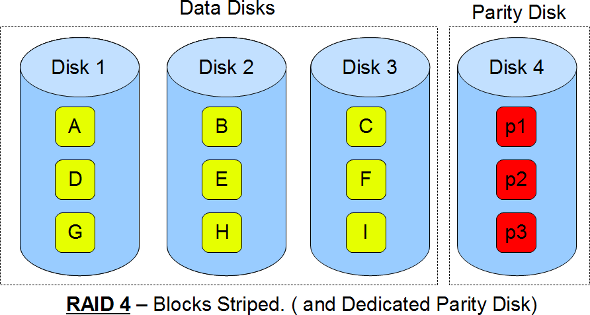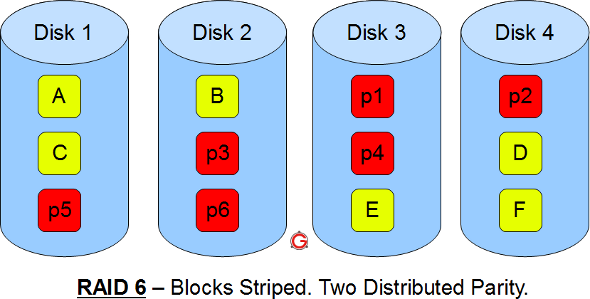In most critical production servers, you will be using either RAID 5 or RAID 10.
However there are several non-standard raids, which are not used except in some rare situations. It is good to know what they are.
This article explains with a simple diagram how RAID 2, RAID 3, RAID 4, and RAID 6 works.
RAID 2

- This uses bit level striping. i.e Instead of striping the blocks across the disks, it stripes the bits across the disks.
- In the above diagram b1, b2, b3 are bits. E1, E2, E3 are error correction codes.
- You need two groups of disks. One group of disks are used to write the data, another group is used to write the error correction codes.
- This uses Hamming error correction code (ECC), and stores this information in the redundancy disks.
- When data is written to the disks, it calculates the ECC code for the data on the fly, and stripes the data bits to the data-disks, and writes the ECC code to the redundancy disks.
- When data is read from the disks, it also reads the corresponding ECC code from the redundancy disks, and checks whether the data is consistent. If required, it makes appropriate corrections on the fly.
- This uses lot of disks and can be configured in different disk configuration. Some valid configurations are 1) 10 disks for data and 4 disks for ECC 2) 4 disks for data and 3 disks for ECC
- This is not used anymore. This is expensive and implementing it in a RAID controller is complex, and ECC is redundant now-a-days, as the hard disk themselves can do this.
RAID 3

- This uses byte level striping. i.e Instead of striping the blocks across the disks, it stripes the bytes across the disks.
- In the above diagram B1, B2, B3 are bytes. p1, p2, p3 are parities.
- Uses multiple data disks, and a dedicated disk to store parity.
- The disks have to spin in sync to get to the data.
- Sequential read and write will have good performance.
- Random read and write will have worst performance.
- This is not commonly used.
RAID 4

- This uses block level striping.
- In the above diagram B1, B2, B3 are blocks. p1, p2, p3 are parities.
- Uses multiple data disks, and a dedicated disk to store parity.
- Minimum of 3 disks (2 disks for data and 1 for parity)
- Good random reads, as the data blocks are striped.
- Bad random writes, as for every write, it has to write to the single parity disk.
- It is somewhat similar to RAID 3 and 5, but a little different.
- This is just like RAID 3 in having the dedicated parity disk, but this stripes blocks.
- This is just like RAID 5 in striping the blocks across the data disks, but this has only one parity disk.
- This is not commonly used.
RAID 6

- Just like RAID 5, this does block level striping. However, it uses dual parity.
- In the above diagram A, B, C are blocks. p1, p2, p3 are parities.
- This creates two parity blocks for each data block.
- Can handle two disk failure
- This RAID configuration is complex to implement in a RAID controller, as it has to calculate two parity data for each data block.






 My name is Ramesh Natarajan. I will be posting instruction guides, how-to, troubleshooting tips and tricks on Linux, database, hardware, security and web. My focus is to write articles that will either teach you or help you resolve a problem. Read more about
My name is Ramesh Natarajan. I will be posting instruction guides, how-to, troubleshooting tips and tricks on Linux, database, hardware, security and web. My focus is to write articles that will either teach you or help you resolve a problem. Read more about
Comments on this entry are closed.
Ramesh:
Thanks for posting valuable information. I love TGS!
Got a couple of comments regarding your post about RAID 2, 3, 4 & 6:
1) According to what I’ve read, it seems that none of them are suitable for ORACLE Databases. Is that right?
2) Also, would like to know some examples where such RAIDS could be used.
Thanks in advance.
Your articles are great and easy to understand. Thanks for providing us with such valuable information.
Israel, as long as your computer os and hardware will support the RAID configuration then it shouldn’t matter what DB you use. however for a data base critical system I would suggest a hardware RAID controller then it should be transparent to everything
Is there a RAI D 15
thanks for your explained
These diagrams are very helpful and easy to understand. I just wanted to point out that according to the ISM (Information Storage Management) exam, RAID-4’s primary use is for reading large sequential data. During a read with the 3 disks it is essentially functioning as a stripe (RAID 0). So reading large files (like video or ISO files) is a plus with this configuration.
The above article says RAID 4 to not used, yes, but because it is fast and used by NetApp, with RAID 4 RAID DP
Ramesh,
I like the graphical approach you took. Concerning RAID 6, you state two parity blocks per data block, but the diagram shows an equal amount of each.
IRT Taino19xx, he said two parity blocks per data block — but didn’t define “block” where perhaps there are two definitions. Perhaps better stated as two parity blocks per data block group. The above diagrams reflect the minimum number of disks that would ever (probably not) be used. There’s two parity blocks per set of two data blocks in the diagram. In reality there’d be 4, 5, 6, 8, or more data blocks plus 2 parity.
In the explanation of Raid 4, “In the above diagram B1, B2, B3 are blocks” seems it should read “In the above diagram A, B, C are blocks.” It’s a very good explanation article, though. Kudos. Would you perhaps consider giving a high-level, simple explanation of parity in one of these articles, too? It seems it would be more accessible to a reader on the level that needs these explained.
Hi ,
Kindly note we are looking comparison between RAID0+1 and RAID 6 . If storage requirement is of 10 TB . What will be actual required storage in both category . Applicastion is for Video Storage .
hard disc being used are 1 TB.
Regards,
Rakesh Pandey
For a 10TB array with 1TB drives, you’d need 20 drives for RAID 10 (aka 0+1, 1+0) — a stripe of 10 drives, then mirrored with another stripe of 10 drives. OR it’s 5 mirrors of 2 drives, then striped. The differences are purely academic :). For RAID 6, only 12 drives are needed, but you need a RAID 6 card or a significant (couple % of your CPU?) software RAID solution. RAID 6 is a lot more CPU intensive than RAID 5 which is generally unnoticeable load on modern systems except under extreme disk activity. RAID 6 will tolerate loss of ANY 2 drives, where RAID 10 could tolerate up to a loss of 5, but Murphy’s Law says you’ll lose the 2 in the same mirror, so RAID 10 cannot tolerate the loss of ANY 2 drives. After the first loss, there’s one of the other 19 that’s critically important.
Also performance (especially with a RAID card) should be (theoretically) higher for RAID 6.
Dan
This is an awesome explanation, thank you so very very much. I really now feel very comfortable with understanding RAID.
i got somthing new
thanks for your explained
RAID 10, often referred to as RAID 1+0 (mirroring and striping), data is written in stripes across primary disks that have been mirrored to the secondary disks……..thanks fr your EXPLANINED…
The Other way around Mr Mohd
Here is a question regarding the RAID:
What are the advantages and disadvantages of RAID 0, RAID 1, RAID 5 AND RAID 10
hi sir u r posting a very good raid concepts
What RAID would a server usually have?
What RAID would a normal Desktop Computer usually have?
What RAID would an ALL-IN-ONE Computer usually have?
What RAID would a normal Netbook Computer usually have?
What RAID would a normal Laptop Computer usually have?
I am trying to solve a puzzle given a lot of known factors, but I am not familiar with RAID.
The RAID’s I have to choose from are RAID 0, RAID 1, RAID 5, RAID 6, AND RAID 10.
I think the Type of Raid, Which configurations would be used more than once, is dependent on Purposing Your Configurations, on Exactly Your Pen-Ultimate Mission !
Thanks alottttttt….!!!!This article is very much useful and easy to understand and memorize 🙂
Thanks alottttttt….!!!!This article is very much useful and easy to understand and memorize 🙂
In raid 6, how are the parity bits calculated?
(a simple xor would not suffice here, because then it would not be possible to reconstruct bit A and B if drives 1 and 2 were lost)
this Knowledge Sharing article made me easy to understand the concept.. Thanks a load for uploading..:-)